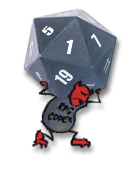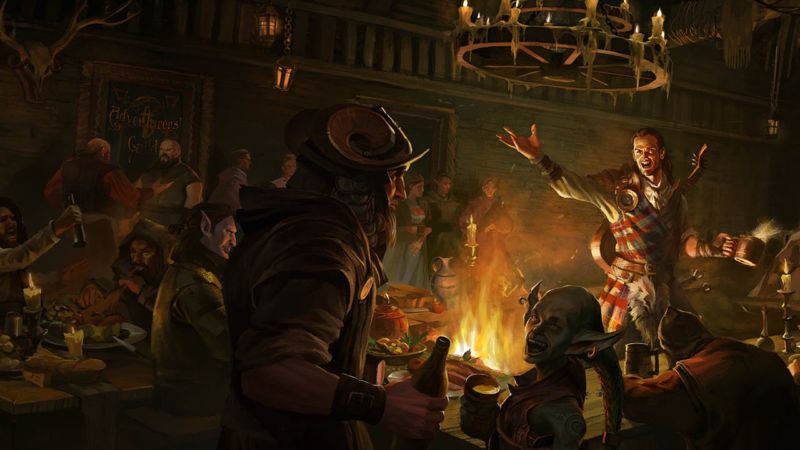Hands-on with Bard’s Tale 4, the first proper series entry in 30 years
Hearthstone meets Might & Magic in this distant descendant.
SAN FRANCISCO—When it was published as
Tales of the Unknown: Volume I in 1985,
The Bard's Talewas the most popular PC RPG yet released. It spawned two sequels, but disputes over contracts and more prevented further development. The series went dormant for 30 years, apart from a comedy action RPG in the early 2000s that bore little resemblance to the original game.
Now, a Kickstarter has given life to
The Bard's Tale IV: Barrows Deep. Developed by Interplay alum-founded inXile Entertainment (
Wasteland 2,
Torment: Tides of Numenera), it's the first game in decades to follow the basic mold of the original series of RPGs, though it takes a few liberties of its own to modernize the franchise (most of them are welcome).
I played a work-in-progress version at the 2018 Game Developers Conference (GDC) in San Francisco, guided by lead designer David Rogers. While I had a few small complaints as a classic CRPG player, I walked away from the demo with the impression that inXile has struck a reasonable balance between the spirit of the hardcore originals and the new, more modern expectations of today's players.
Add some Hearthstone to your classic RPG
Let's start with the combat, which is, by necessity, a bit of a departure from the text-based combat of the original
Bard's Tale. In this game, each battle takes place on a grid of tiles overlaid on top of the existing 3D world, representing the spaces characters can occupy. Half of the tiles—those closest to my perspective—could only be inhabited by my party members, while the other half could only be occupied by enemies. It's a turn-based system in which you assign a set number of action points for your party, then end your turn to see the resulting melee.
Positioning is key in this battle system; placing a fighter in front of a mage to protect the latter from many attacks is a good strategy, for instance. Each attack, on both sides of the battlefield, only affects tiles in a preset range. One attack might light up a T-shape of tiles, while others would attack in a straight line, for example. Those attacks are determined partly by your characters' abilities, but others were made available to characters by the equipment they carried.
The flow of the game felt very similar to that of digital card games like
Hearthstone or
The Elder Scrolls Legends. Each battle was a puzzle that could be solved by arranging party members in the right formations and spending action points on the right actions. And there was just a little bit of randomness to make things interesting now and then—though the demo I played didn't have nearly as much randomness to it as one would find in a zany
Hearthstone match.
inXile may have examined the marketplace and determined that older gamers who played the original series, now strapped for time, have gone on to play a lot of games like
Hearthstone. So the new flow works well, even if it's not very similar to the action we saw in the original games. Still, there are just enough faithful homages in there to make things feel authentic.
My main complaint when playing was that the user interface for battles seemed inconsistent and unintuitive. Each space on the grid is differently sized, making positioning your characters and planning attacks a bit weird. Your own party appears as sprite drawings that are overlaid on the grid squares closest to you; this is odd, given that the enemy party members are in full 3D on the same grid. That said, I found myself engaged by pulling off amusingly effective and devastating strategies on my enemies with synergistic character abilities, all while frantically working to reposition my party members in anticipation of big attacks from the other side.
Exploring and puzzles
Outside of battle,
The Bard's Tale IV gets rid of the tile-based movement for a free-roaming, first-person perspective very similar to those of other first-person, party-based RPGs.
Update: inXile says that an optional tile-based movement mode is coming, too.
The environment I was exploring—some kind of ancient ruin dungeon—was pretty standard fantasy fare. Unlike the original game, though, I didn't run into any random battles. I could see every enemy in the world, and combat would commence as soon as they saw me (or if I fired a stealthy first shot to gain initiative). Every combat encounter concluded with a chest that opens with a loot box-style flourish—but don't worry, they're only acquired through in-game means.
The
Bard's Tale series is known for its puzzles, and those are back as well—as are the bard songs that help you solve them. I only got to use one of these in my demo, letting me shatter damaged walls to find secret passages in some puzzles. It was never very clear to me which walls could be broken and which couldn't, though. Another puzzle played out as sort of a memory game to match rune-like symbols on a device in one area to those I saw written on the wall in another area.
I was also quickly reintroduced to the series' quirky and sometimes macabre sense of humor through a man with a knife sticking in his eye socket, who complained that he wished he could pull it out so he could just die already.
Lead Designer David Rogers told me the company reused assets from its VR game
The Mage's Tale in making this game, and the result is a strong visual style. Rogers said that the game features robust town environments, too, but I was not able to explore those in this demo.
Impressions
I came away from my demo feeling that
The Bard's Tale IV served as an effective homage to the original games, and it has been updated to fit the schedules of older gamers whose tastes might have turned a bit more casual in recent years.
Not that the turn toward a more casual audience is a bad thing. The returned gameplay is very fun, and the spirit of the originals is still present despite the changes. That's not too surprising, since original series creator Michael Cranford agreed to consult, and former Interplay executive Brian Fargo is the leading sequel developer at inXile, too.
There were several problems with inconsistency and lack of clarity in the user interface that I found irritating, but I don't think they were glaring enough to trouble most of the game's core audience. Let's be honest, this is still a big step up from the awful interfaces on many classic computer RPGs. And the interface will likely be polished further with additional development time.
Kickstarter backers (who helped contribute items and such to the game) can already play this demo version. Others will have to wait for a $39.99 PC, Mac, and Linux release later this year.



































